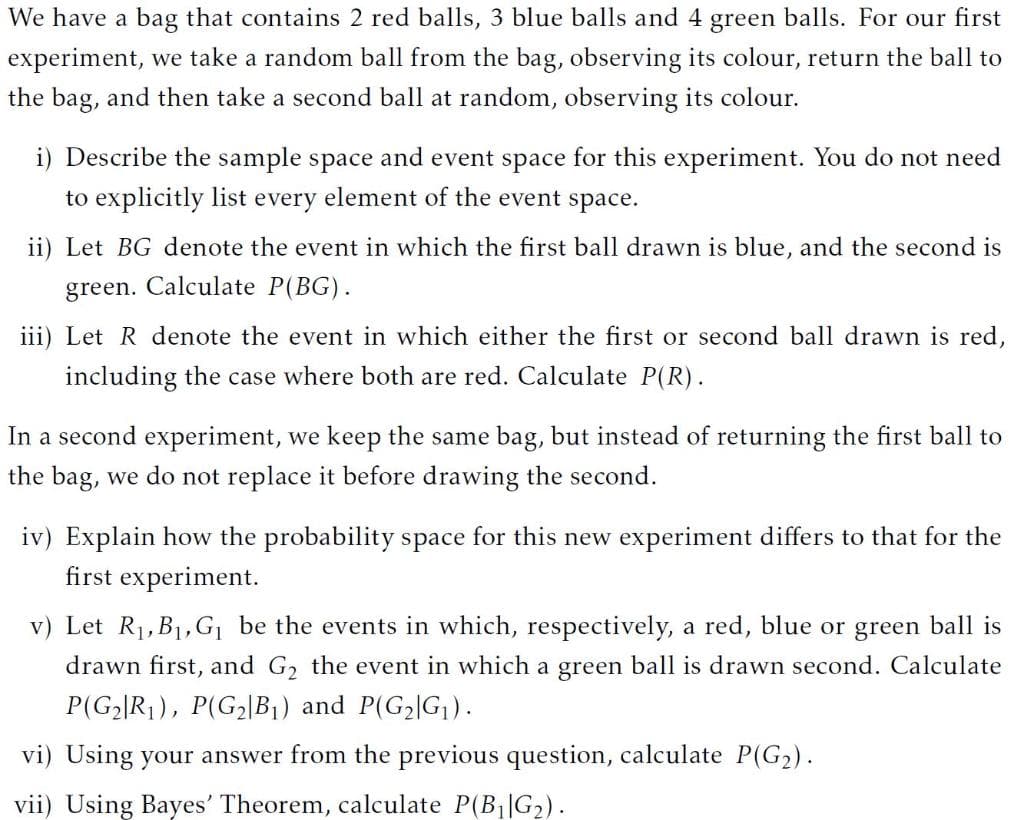We have a bag that contains 2 red balls, 3 blue balls and 4 green balls. For our first experiment, we take a random ball from the bag, observing its colour, return the ball to the bag, and then take a second ball at random, observing its colour. i) Describe the sample space and event space for this experiment. You do not need to explicitly list every element of the event space. ii) Let BG denote the event in which the first ball drawn is blue, and the second is green. Calculate P(BG). iii) Let R denote the event in which either the first or second ball drawn is red, including the case where both are red. Calculate P(R).
We have a bag that contains 2 red balls, 3 blue balls and 4 green balls. For our first experiment, we take a random ball from the bag, observing its colour, return the ball to the bag, and then take a second ball at random, observing its colour. i) Describe the sample space and event space for this experiment. You do not need to explicitly list every element of the event space. ii) Let BG denote the event in which the first ball drawn is blue, and the second is green. Calculate P(BG). iii) Let R denote the event in which either the first or second ball drawn is red, including the case where both are red. Calculate P(R).
A First Course in Probability (10th Edition)
10th Edition
ISBN:9780134753119
Author:Sheldon Ross
Publisher:Sheldon Ross
Chapter1: Combinatorial Analysis
Section: Chapter Questions
Problem 1.1P: a. How many different 7-place license plates are possible if the first 2 places are for letters and...
Related questions
Question

Transcribed Image Text:We have a bag that contains 2 red balls, 3 blue balls and 4 green balls. For our first
experiment, we take a random ball from the bag, observing its colour, return the ball to
the bag, and then take a second ball at random, observing its colour.
i) Describe the sample space and event space for this experiment. You do not need
to explicitly list every element of the event space.
ii) Let BG denote the event in which the first ball drawn is blue, and the second is
green. Calculate P(BG).
iii) Let R denote the event in which either the first or second ball drawn is red,
including the case where both are red. Calculate P(R).
In a second experiment, we keep the same bag, but instead of returning the first ball to
the bag, we do not replace it before drawing the second.
iv) Explain how the probability space for this new experiment differs to that for the
first experiment.
v) Let R1,B1,G be the events in which, respectively, a red, blue or green ball is
drawn first, and G, the event in which a green ball is drawn second. Calculate
P(G2|R1), P(G2|B1) and P(G2|G).
vi) Using your answer from the previous question, calculate P(G2).
vii) Using Bayes' Theorem, calculate P(B||G2).
Expert Solution
This question has been solved!
Explore an expertly crafted, step-by-step solution for a thorough understanding of key concepts.
This is a popular solution!
Trending now
This is a popular solution!
Step by step
Solved in 2 steps

Follow-up Questions
Read through expert solutions to related follow-up questions below.
Recommended textbooks for you

A First Course in Probability (10th Edition)
Probability
ISBN:
9780134753119
Author:
Sheldon Ross
Publisher:
PEARSON


A First Course in Probability (10th Edition)
Probability
ISBN:
9780134753119
Author:
Sheldon Ross
Publisher:
PEARSON
